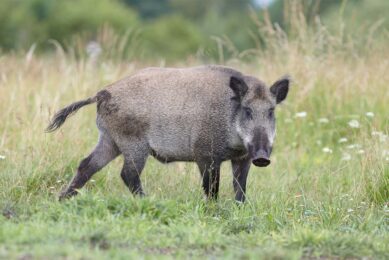Preparing for ASFv: An ‘enveloped virus’

As there is currently no vaccine for African Swine Fever, the only way to fight the virus is to have extremely good biosecurity practices in place on farm and across borders. Knowledge is power in this respect: ASFv is an ‘enveloped virus’. What does this mean in practice and how does it help to be as well prepared as possible?
As is well known, African Swine Fever (ASF) is a highly contagious viral haemorrhagic disease that can be fatal to pigs and wild boars. Currently, for this virus, no approved vaccine exists.
According to different sources, the routes of transmission of the infectious agent are as follows:
- Oro-nasal route by contact with an infected animal carrying the virus and by exchange of secretions. The virus is present in all body fluids and tissues of the infected animal;
- Oro-nasal route by direct contact with the virus present in the environment where it can survive (excrement, fodder, liquid manure, manure, litter, equipment, vehicles, clothing, etc.);
- Through the air, in the barn, over very short distances in the case of high density pigs;
- Ingestion of water or contaminated food (contaminated food waste, contaminated fresh meat that has not been sufficiently heat treated, etc.);
- Bites from ticks of the genus Ornithodoros carrying the virus and biting flies as well.
Sensitive to disinfectants
African Swine Fever virus is a double stranded DNA virus single member of genus Asfivirus and the family Asfarviridae. Several genotypes (22) of the species have, however, been identified and virulence differs greatly from one isolate to another.
The extracellular enveloped viruses have a diameter that varies between 175 to 215 nm. They are relatively large compared to other viruses, some of which only measure 10 to 30 nm (see Figure 1). Their capsid is an icosahedral structure of capsomeres surrounded by an outer layer mainly made up of lipids, qualifying them as large enveloped viruses. This outer envelope is essential for infection.
In the fight against ASF, it is an advantage that these viruses belong to groups of large enveloped viruses, as they are much more sensitive to disinfectants than viruses without an envelope (known as ‘naked’), especially if they are small.
That is why the virucidal activity of disinfectants is tested on a reference virus: Cytopathic Bovine Orphan (ECBO) virus. It is a small naked virus (27 nm in diameter), easy to grow in the laboratory and very resistant to biocides. Therefore, the disinfectants’ virucidal activity which has been demonstrated on this reference virus, according to European standardised methods, is capable of demonstrating virucidal activity on ASFv, whatever the genotype.
Figure 1 – Classification of virus sensitivity to common disinfectant. Small and naked viruses are more difficult to kill than big enveloped viruses.
Dissemination of the virus
The virus is relatively resistant in the environment and can therefore spread very quickly. Some strains can remain infectious across a wide range of pH values from 4 to 13. Studies also show virulent activity of strains stored for five and seven years at 5°C, for 18 months at 20°C and between ten and 30 days at 37°C. The virus can also survive in protective media such as soil or animal faeces for five to six months and up to 30 months in chilled meat. However, it is inactivated at a temperature of 60°C applied for 30 minutes.
In general, it is observed that resistance and survival of enveloped viruses is much higher based on temperatures below 10°C compared to high temperatures (above 20°C), in the environment or under disinfectant treatment (see Table 1).
General biosecurity measures
The fight against the disease lies in prevention: avoiding the spread of the virus from infected or endemic areas (strict imports, monitored transportation of animals, etc.). On farms, it is essential to ensure the protection of the animals with regards to all external sources and entrants:
- Access to buildings should be controlled: use of personal protective equipment is pivotal to access livestock buildings;
- Footbaths should be placed at the entrances of each building;
- Vehicles should be cleaned and disinfected inside and out and on-site (including inner parts of the mudguard);
- Tractors and trailers used should be cleaned and disinfected to remove manure;
- All clothing should be washed at 60°C;
- Improvement of building maintenance, pest control, rodent control, liquid manure removal, etc.;
- Improvement of cleaning and disinfection procedures on all surfaces of buildings and equipment and the environment in general;
- Monitoring of entrants (food, water, etc.);
- Monitoring of animal health (abnormal signs or symptoms).
Biocidal strategy
Animal health company Huvepharma is marketing the biocidal glutaraldehyde/ammonium products Vulkan Max and Vulkan Air. Both have been tested on ECBO virus according to EN standards. Vulkan Max, in particular, demonstrated efficacy on specific ASFv:
- At less than 0.8%, according to the last EN 14675 standard; 30 minutes at 10°C;
- At 0.2% according to the Russian standard; 1 hour at 20°C at low soiling level conditions;
- At 0.5% according to the Russian standard; 1 hour at 20°C at high soiling level conditions.
If the disease is reportedIf a case is proven, establishment of a management procedure for hazardous areas includes:
|
As observed in Europe and in some regions of Asia, the transmission of ASF seems to depend largely on the wild boar population density and their interaction with low-biosecurity pig production systems. Good knowledge and management of the wild boar population and a good coordination among the veterinary services, wildlife and forestry authorities are required to successfully prevent and control ASF.
References available on request.
 Beheer
Beheer








 WP Admin
WP Admin  Bewerk bericht
Bewerk bericht